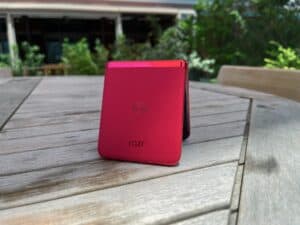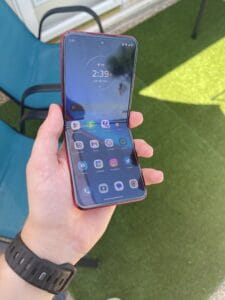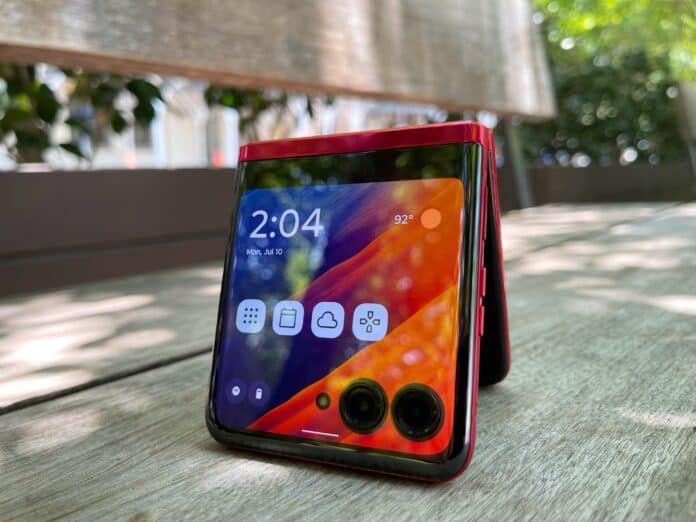By Andrew Utterback
Released in 2019, Motorola’s first attempt at a folding phone, the Motorola Razr, left quite a lot to be desired. Its poor build quality, camera performance, and high starting price of $1,500 caused it to easily lose to its folding phone foes. Four years later, Motorola released the Razr+, which I have used for the past two weeks. This phone not only fixes nearly every problem with the original Razr, but it also may be the best “flip” phone on the market. At least for now…
There is one standout feature of the Razr + which is, of course, the massive front cover display. This phone is a “flip” phone just like the Samsung Galaxy Z-Flip 4, but unlike the Z-Flip, it has a cover screen that lets you use the phone to a surprising degree, without opening it. The cover display is a 3.6 inch 144hz p-OLED display. It shows the time, date, and weather via the always on display, but upon unlocking the phone, you are greeted with an actual home-screen on the front of the phone. It now displays a full
wallpaper, along with little widgets that Motorola calls “panels.” These panels allow you to quickly slide between your app drawer, calendar widget, weather widget, game page, and other quick action widgets, all without opening the phone. You can launch full apps on the cover screen and interact with them just as you would if the phone were open. You can respond to texts with a full size keyboard shuffle through your Spotify playlist, or even scroll through headlines. Holding down on the navigation bar at the bottom causes the display to extend downward, wrapping itself around the two cameras and flash, allowing for an even more immersive UI.
In practical use, this is fantastic. One annoyance I had with other flip phones like the Z-Flip, is that you have to open the phone to respond to a text or open your Instagram notification. That required opening action makes the entire concept of a flip phone less appealing, because as Motorola said themselves in the release event, “If you’re gonna open it up all the time, you might as well just go buy a candy-bar phone.” This cover-screen let me take the phone out of my pocket at the gym, message a friend and add a song to my Spotify queue, all without opening it. It’s pretty handy for small, quick action tasks like that, but almost every time I need to do something that takes me more than a few seconds to complete, I find it worth it to take the extra 2 seconds (if that) to open, or flip, the phone.
When you do actually open the phone, you get a perfectly fine, 2023 Android phone experience. We get a 6.9 inch 165hz OLED display, which in my use has been pretty good. It’s just bright enough outside and looks fine in normal use. My only knock would be that the display is only HD, but at this price point that’s not a huge deal. The display folds in half via a surprisingly smooth crease in the center, which is noticeably more discreet than Samsung’s. The display hinge feels mostly solid and rests firmly in whatever folding degree you choose. Both halves rest perfectly parallel when closed (Something the Z-Flip 4 still does not do) and the featured, animated wallpaper I chose seamlessly flowed from the bottom half to the top when opening the phone.
The Razr+ has a fingerprint sensor built into the power button, which was fairly fast and rarely missed my finger. It was almost in a too-natural spot. Often, I would put the phone
in my pocket (folded up) and my thumb would naturally be resting on the power button, thus unlocking it while in my pocket. Minor inconvenience that can be fixed with a different finger placement (I know), but still worth mentioning.

My review unit came in this very nice looking red color with a great feeling faux leather back. Since the top half of the fully unfolded Razr + is a glass screen, the texture change of the “leather” was honestly a nice touch. The “leather” does not scratch easily, and the aluminum side rails held up just
fine in my two weeks of case-less use.
Toward the end of the second full day of use, I noticed the hinge making a strange sound. I then repeatedly opened and closed the phone, and every time, the hinge would make a squeaking sound. This continued the entire week, and since I had only been using it two days, this was not a result of any user error or damage. I reached out to Motorola for a statement and never heard back from them.

Android 13 has been great for me, with very few bugs. Motorola has left the Razr+ running basically stock android, with a couple Moto features and easter eggs here and there. Oneodd characteristic is that the phone lets you use the rear screen as a camera viewfinder when folded…but the viewfinder is always on. So unfold your phone and hold it up to take a picture, and everyone in the rooms sees that you’re taking a picture. Anti spy feature I guess?
Speaking of pictures, the Razr+ takes…interesting ones. The camera on the Razr+ in my testing has been more “fun” than good. The outside screen, when not used as a viewfinder, can display cartoon smiling faces when the camera is pointed at a human face. The selfie camera has an entire selfie editing mode, which gives you a host of sliders to slim down your face, shrink your nose, enlarge your eyes, and smooth out any imperfections. It works worse than free selfie editing apps available, and leads to discussions regarding people’s self image.


Hardware wise, the Razr+ features a 12 MP main camera and a 13 MP ultra wide, an underwhelming 2023 layout for sure, but on par with other foldables. In terms of raw camera performance, the Razr+ is fine. I spent a day taking a wide variety of photos downtown, and I’m not necessarily impressed, but also not surprised. Like any other “average” camera, if you throw enough light at a sensor, the photos will look good. In broad daylight, the Razr+ produces good photos with a decent level of detail and strong colors. The HDR is a bit overpowering every now and then, but overall, it’s fine. The sharpness and overall detail is normal for a sensor of this size and looks more than okay for your Instagram. Where this camera starts to do too much is color. Photos I took of plants especially were so overpowering that the entire image looked fake.
The camera made the green leaves so green that the photos all looked heavily edited. Other times though, the color was acceptable and produced a fairly good photo. Videos on the Razr+ are okay in decent light but pretty grainy in darker environments, and night mode photos in those darker environments are also sub-par. In my testing, I put the Razr+ up against the widely acknowledged camera king: an iPhone 14 Pro Max. Is this a little unfair? Yes. But still, looking at the two phones, which mind you, are only $100 apart, there is a massive difference favoring the iPhone. The iPhone doesn’t fold though, and that’s really why you’re buying this phone…but when you do decide to snap some photos, the cameras are fine, yet not stellar.
Performance has been more than adequate, while not quite top end. The Razr+ is running last year’s Snapdragon 8 Gen 1 chip, which is snappy enough for this $999 phone. Running through my everyday apps was a breeze and the Razr+ was decent while gaming. Heat wise, the device did get quite warm while fast charging, but on slower chargers or a wireless charger it wasn’t bad. My Razr+ had 8gb of RAM (Higher storage models get 12gb) and 256 GB of storage (UFS 3.1). Both of those numbers are perfectly fine; however, the RAM performance has been iffy during my usage. Apps are not held open very long and frequently have to reload. This can most likely be fixed via a software update and shouldn’t be a big problem.
Battery life has been pretty solid as well. The Razr+ has a 3800 mAh battery that has gotten me a comfortable 5-6 hours of screen on time a day. For a battery of that size and a 165hz display, that’s good. The phone can also fast charge using Motorola’s amazingly named “Turbo Power” 30w fast charging.
I’ve spent the last two weeks with the most “fun” phone I’ve ever used. Not the best overall, not the most advanced, but the most fun. From the bubbly smiling camera faces, to the “retro Razr” mode, which turns the phone display into that of the old fashioned Razr flip phones, this phone was exciting to unfold. And as it turns out, that’s good enough for some people. The majority of smartphones all look and function the same, so when we get a groundbreaking new “innovation,” it catches the eye of a
“normal” phone buyer. That’s what Samsung’s foldable phones have done for the past 4 years. The Motorola Razr+ is not revolutionary, but it has added a fantastic feature to an already successful form-factor, and has done so in a way that works and looks great. The one problem with this phone is that no phone exists in a vacuum. Samsung’s Z-Flip 5 will be announced July 26 2023, and is heavily rumored to have a larger cover display just like the Razr+. That phone will likely have a more refined hinge than the Razr, with better cameras, and a newer processor. Once again, this is all speculation, but it’s important to consider before buying.
The Motorola Razr+ is a great phone. It is the next iteration of a now tried and true folding form-factor, and features a cover display that makes it, for me, the most usable “flip” phone on the market. If you are in that market right now for a folding phone and you are ok with compromises here and there, then you will thoroughly enjoy this phone. But for those who may want a few less compromises and are willing to wait, then you may just want to watch the folding phone horizon for a little while.









































